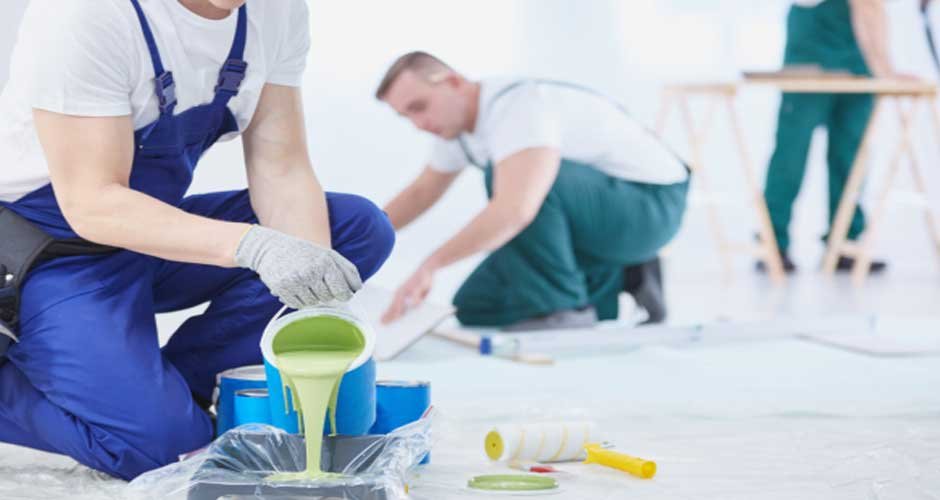Refreshing the look of your home can be as simple as giving your concrete wall a fresh coat of paint. Whether you’re aiming to rejuvenate a dull space or protect your walls from damage, understanding how often to repaint is crucial. If you’ve noticed signs of wear like fading, chipping, or stains, it might be time to take action.
This guide will help you navigate the process of maintaining your interior concrete wall, ensuring they remain both beautiful and durable. Ready to transform your space? Let’s dive into the essentials!
Understanding Concrete Walls
Concrete walls – known for their toughness and long life – are solid choices for places like basements, garages, and industrial spots. But hey, with time, even these sturdy walls show a bit of wear and tear. So, to keep them looking good and strong, a new paint job is a must. It not only freshens up their look but also keeps them sturdy for the long haul.
Signs Your Concrete Walls Need Painting
There are clear signs that tell you when it’s time to paint your concrete walls. Look for these signs:
- Fading Color
- Chipping or Peeling
- Stains
- Cracks
If your wall color appears lackluster, a fresh coat of paint might be in order. Peeling paint signals the need for a repaint. Unsightly stains from moisture or dirt can mar your walls. Address any emerging cracks promptly to prevent further damage and ensure a pristine finish.
Frequency of Painting
When you’re thinking about how often to paint your concrete walls inside, there are a few things to consider. Think about the type of paint you’re using, how much the walls are used, and the look you’re going for. All these factors help decide when it’s best to repaint. By looking at these things closely, you can figure out a schedule for painting that’ll keep your walls looking great for years!
Location Matters
The location of the wall is a crucial factor in determining the frequency of repainting required. Walls situated in high-traffic zones or areas prone to moisture, such as bathrooms and basements, demand more regular attention. Typically, these spaces may necessitate repainting every 3 to 5 years to maintain a fresh and appealing appearance.
Quality of Paint Used
The type of paint you use is a crucial factor in determining the frequency of repainting your surfaces. Opting for high-quality paints not only ensures a longer-lasting finish but also contributes to the overall durability and appearance of your paint job.
It’s advisable to thoroughly review the manufacturer’s recommendations for the specific paint you select, as this can provide valuable insights into the maintenance and longevity of your painted surfaces.
Environmental Factors
Environmental factors such as humidity and temperature can significantly accelerate wear and tear on painted walls. For instance, in humid regions, the moisture in the air can lead to more frequent paint touch-ups.
Similarly, direct exposure to sunlight, particularly if the wall is located close to a window, can expedite the fading of paint colors, necessitating more regular maintenance to keep the walls looking fresh and vibrant.
Preparation Before Painting
Before starting the painting process, thorough preparation is crucial to ensure a successful outcome. Begin by meticulously cleaning the wall surface to eliminate any traces of dirt or mold that could hinder the paint’s adhesion.
Additionally, inspect the wall for cracks or holes that may require patching to achieve a smooth finish. Consider applying a primer before painting to enhance the paint’s durability, adhesion, and overall finish, ensuring a long-lasting and professional-looking result.
Choosing the Right Paint
When selecting the ideal paint for your concrete wall, it’s crucial to consider various factors. Opt for a paint specifically formulated for concrete surfaces to ensure optimal results. These specialized paints boast unique properties that promote strong adhesion, durability, and moisture resistance, offering long-lasting protection and a pristine finish for your concrete walls.
The Painting Process
When it comes to painting, follow these steps to ensure a good job:
- Gather Your Tools
- Prepare the Area
- Apply the Primer
- Painting
- Dry Time
For a successful painting project, you will need the following supplies: paint, brushes or rollers, a tray, masking tape, and drop cloths. Begin by moving the furniture away and covering the floor with drop cloths to shield it from any potential spills.
If necessary, start with a coat of primer to enhance paint adhesion and ensure a smooth finish. For painting, tackle the edges first using a brush, then switch to a roller for the larger expanses.
Ensure to apply the paint in uniform strokes. For the best outcome, allow the first coat of paint to dry thoroughly before considering the application of a second coat. This step guarantees a sleek and uniform appearance, significantly boosting the aesthetic appeal of the space.
Maintenance After Painting
Once your concrete walls are painted, it’s crucial to provide them with proper care to maintain their appearance and durability. Be sure to inspect the walls regularly for any signs of wear, such as peeling paint or cracks, and address them promptly to prevent further damage.
Additionally, consider cleaning the walls occasionally to remove accumulated dust, dirt, or stains. By incorporating these simple maintenance practices into your routine, you can keep your painted concrete walls looking fresh and well-maintained for years to come.
If you’re looking for more detailed guidance on choosing the right materials and techniques for your painting project, or if you want to explore additional maintenance tips for your home, go to this page. There, you will find a wealth of resources that can help you ensure your concrete walls not only look great but also stand the test of time.
Determining the Ideal Frequency for Repainting an Interior Concrete Wall
In summary, how often you paint your interior concrete wall depends on several factors, including location, quality of paint, and environmental conditions. Keep an eye out for signs that your walls need paint and maintain them well.
By doing this, you ensure that your space looks fresh and inviting while also protecting the underlying concrete. Remember, a good paint job can last several years, but with proper care, you can extend its life even further.
For more on this content, visit the rest of our blog!





